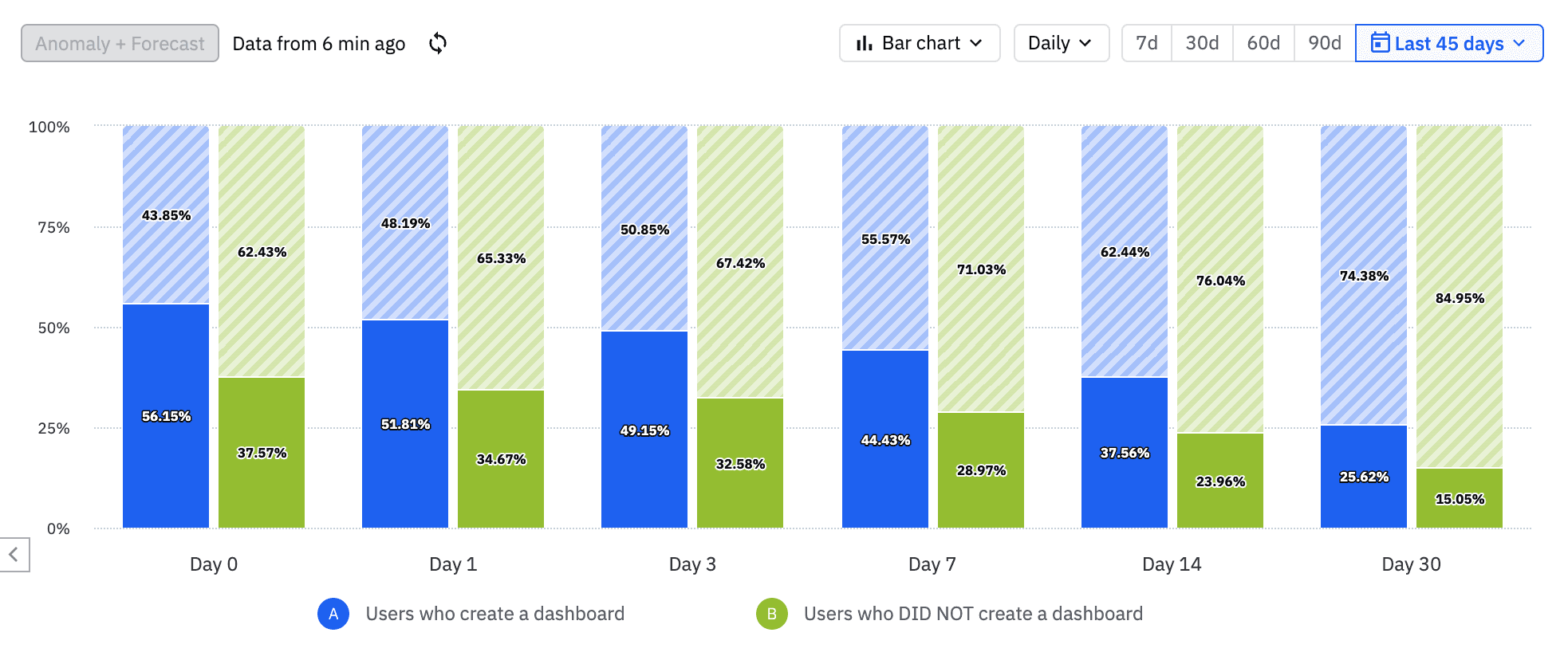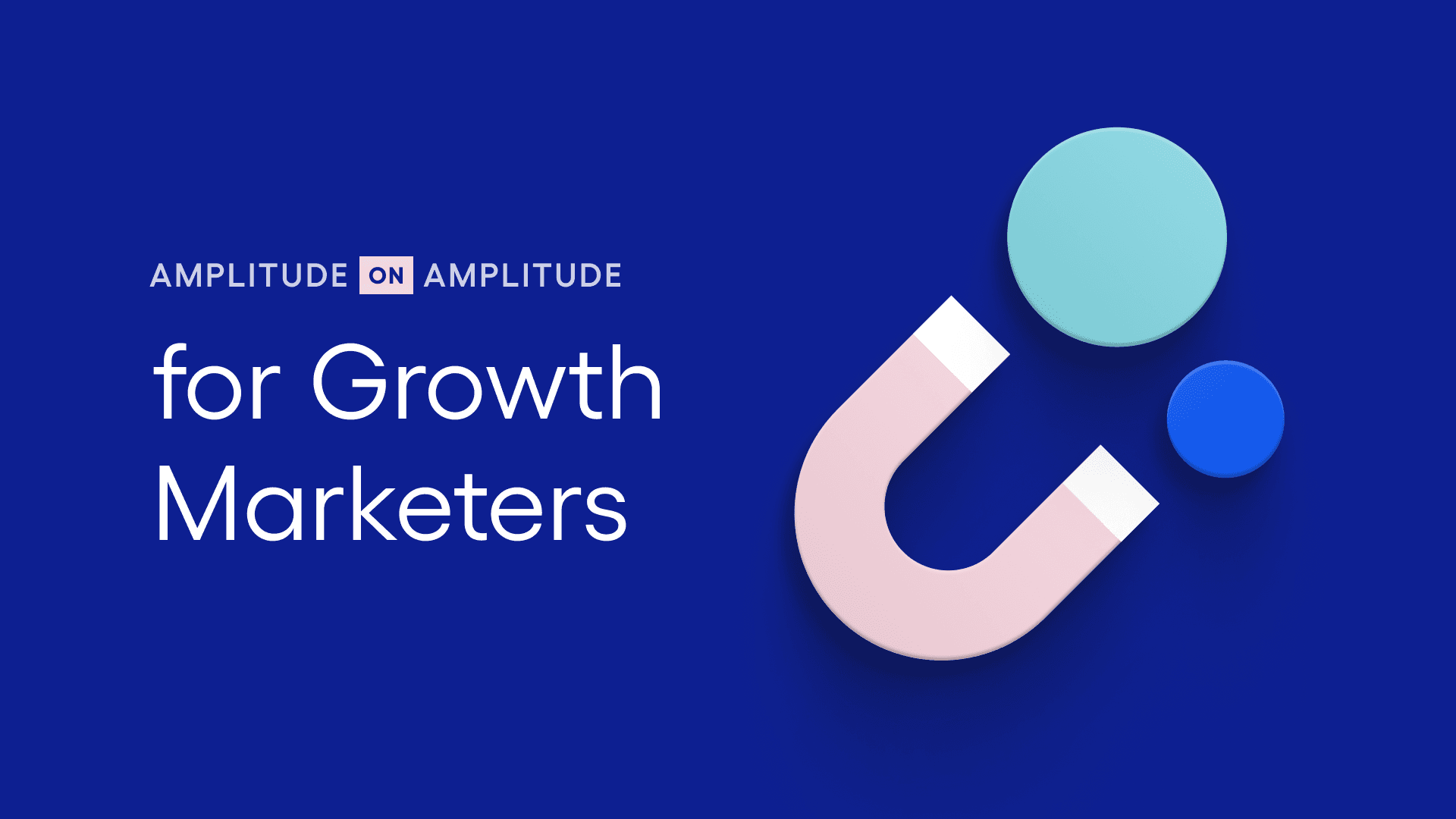How Amplitude Uses Amplitude to Boost Long-Term Retention
Learn how Amplitude growth marketers use the Amplitude platform to keep our customers engaged and coming back.
This post is part two of a four-part Amplitude on Amplitude for Growth Marketers blog series.
Companies care a lot about customer acquisition—so much that they structure their teams and set company-wide goals around it. These goals then trickle down to growth marketing teams that become laser-focused on expanding their customer base. The problem with this model is that retention becomes an afterthought—despite being essential to the long-term health of a business.
Companies invest a lot in product and marketing to acquire high-intent customers. Losing them comes with a significant cost to the business.
As a growth marketer at Amplitude, I focus on customer retention—ensuring that customers continue to find value in our platform long after they've started using it. In this post, I’ll share how we use the Amplitude platform to improve customer engagement and retention.
Key takeaways
- We use Amplitude to track weekly changes in key customer metrics, enabling us to quickly spot and address potential churn.
- Our retention strategy involves segmenting data to understand diverse customer behaviors and how they impact retention.
- We create targeted retention programs by building cohorts based on customer personas and behaviors and syncing these with third-party marketing tools.
Tackling churn early on
Our approach to churn is proactive. We use the Amplitude platform to map and measure the end-to-end customer journey. By keeping an eye on weekly trends in key retention-related metrics, we can detect early warning signs and take action.
For example, if we notice a metric trending down, we use Amplitude to investigate further:
- The first step is to see if there’s a simple explanation: Could this be a bug or data issue?
- Next, we compare historical data to see if the trend is seasonal variation.
- From there, we can slice the data to determine whether specific customer groups are more affected than others.
If we uncover a bug or a similar issue, we swiftly address it. But if the trend suggests a deeper, more systemic problem, we collaborate with our product team to implement marketing and product strategies designed to counteract churn.
Getting a more complete and nuanced understanding of retention
In addition to monitoring overall business health, Amplitude enables us to dig deeper and get a complete picture of customer behavior. We segment our retention data to identify short- and long-term trends and see how different factors influence customer behavior over time.

This example chart shows the retention rates for users of a project management software. Users who don’t create a project tracking dashboard (green) have a higher churn rate of nearly 85% after 30 days. We run similar analyses at Amplitude—try it yourself in Amplitude’s self-service demo or explore your data using our free Starter plan.
One important factor in customer retention is the activation rate. At Amplitude an important activation step is measuring how easy it is for customers to get their data into Amplitude from various sources, like implementing an SDK or bringing data in from a warehouse. By segmenting customers by data source and running a retention analysis, we can understand how each source affects retention.
For example, our analysis might show that customers using a certain source have a lower initial activation rate due to a more challenging sign-up process. Despite the additional upfront friction, those customers might have higher retention rates in the long term. These kinds of insights are only possible because we combine the analysis of primary metrics like activation with retention charts split out by different factors.
Once we have a more nuanced picture of our customers, there are several ways we act on our insights. In this example, we can take our findings to other teams and weigh the pros and cons of marketing to customers with different data sources. We might decide we are willing to accept a lower activation rate upfront for higher long-term engagement and tailor our marketing strategies accordingly.
Using cohorts to run targeted retention programs
One of the core strategies we employ is leveraging Amplitude to build cohorts—segmented groups of customers—so we can run personalized programs based on their unique needs and help them get the most value from our platform.

The cohort above shows users who signed up but did not proceed to add a report. This segment is ripe for personalized messaging that nudges them toward report creation.
Cohorts consist of groups of different personas or customers with similar behaviors. Let’s say we see someone look at information about a particular data source but not send data into Amplitude. We’ll know that they were at least interested in that source, and we can send them helpful resources around it.
After building cohorts in Amplitude, we can send these audiences to other marketing tools like Userflow or Intercom and build personalized messages either in-app or via email. We also tailor resources by persona. If you’re a marketer signing up for Amplitude, the journey we send you down will differ from that of a backend engineer.
As we run these programs, we measure them against the metric we’re trying to impact—like retention rate—and feed that data back into Amplitude. We check if the action we took—sending an email with resources—had the impact we expected by tying engagement back to in-product behavior. With that data, we can determine whether people who opened the email sent data at a higher rate and adjust our future programs based on the results.
Case study
Using Data Assistant recommendations to bring people back to the product
One of the retention programs we piloted with the data team is focused on Amplitude’s Data Assistant, an AI-powered feature that provides data taxonomy recommendations.
We found that people who naturally discovered the Data Assistant were using its suggestions. But not enough people were finding it and actively managing their data, which is key to having a positive Amplitude experience.
With this insight, we designed a weekly email roundup to share taxonomy recommendations from the Data Assistant directly in customers’ inboxes. We built cohorts based on customers who had the account permissions and technical profiles to understand and implement these recommendations. The result? We drove people back to the product to actively manage their data, enabling them to be successful in the long run.
Finding a scalable way to add human intervention to campaigns
As a company, we’ve been working on making it easier for customers to sign up and get started without needing input from the Amplitude team. But organizations differ in their level of analytics complexity, so sometimes, you can’t replace a technical expert.
Enterprise customers have dedicated account teams, but we also have human touches to support our self-serve customers in a scalable way. For example, we use Amplitude to determine whether webinars, office hours, or other one-to-many interventions help customers engage and find value compared to lower-lift interventions like the Amplitude Help Center.
Build customers for life with Amplitude
As a growth marketer, I know how important retention is to achieving sustainable business growth. But to build the kind of engagement that fuels long-term retention, I need insight into how customers behave across the full journey.
With Amplitude, I can easily gather these critical insights and turn them into targeted retention strategies that earn loyal customers for life.
Are you a growth marketer looking to get the data you need to boost engagement and retention? Get started with a free Amplitude account, or learn more about how Amplitude supports growth marketers.

Lilli Clark
Director of Lifecycle Marketing, Amplitude
Lilli is Director of Lifecycle Marketing at Amplitude, where she focuses her team on building programs that support Amplitude customers through the entire customer lifecycle. She enjoys partnering with Product, Go-to-Market, and other cross-functional teams to build a cohesive customer journey. Lilli loves talking all things PLG, lifecycle, and email marketing.
More from Lilli




